Nurse Intervention in Home-Based Cancer Care: A Systematic Review
VerifiedAdded on 2022/10/16
|27
|7970
|130
Report
AI Summary
This report presents a systematic review focusing on the impact of nurse interventions in home-based care for cancer patients. It addresses the increasing incidence of cancer and the importance of post-treatment care in preventing relapse. The review explores various interventions, including physical therapy, targeted interventions, specific diets, pain management, and pressure sore management, highlighting their role in improving patient outcomes. It discusses the significance of nurses in providing emotional support, educating patients about relapse symptoms, and coordinating care. The report emphasizes the need for continuous monitoring, dietary planning, and tailored after-care strategies to enhance patient survival rates and overall well-being. The review also examines the challenges in home-based cancer care and the interventions to overcome them, such as physical activity, pain medication, and pressure ulcer prevention. It concludes by highlighting the need for nurses to provide holistic care that addresses the physical, emotional, and psychological needs of cancer patients.
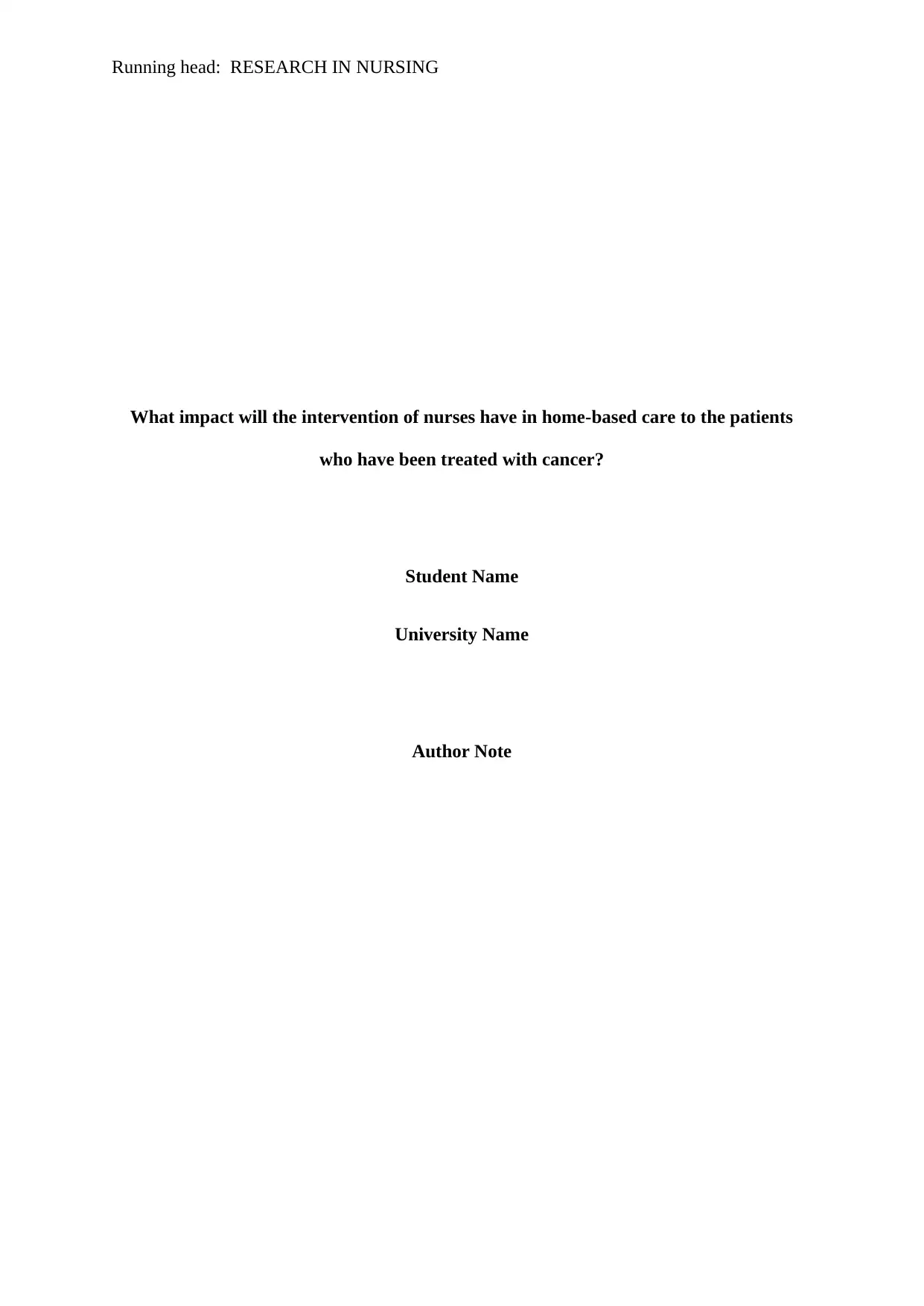
Running head: RESEARCH IN NURSING
What impact will the intervention of nurses have in home-based care to the patients
who have been treated with cancer?
Student Name
University Name
Author Note
What impact will the intervention of nurses have in home-based care to the patients
who have been treated with cancer?
Student Name
University Name
Author Note
Paraphrase This Document
Need a fresh take? Get an instant paraphrase of this document with our AI Paraphraser
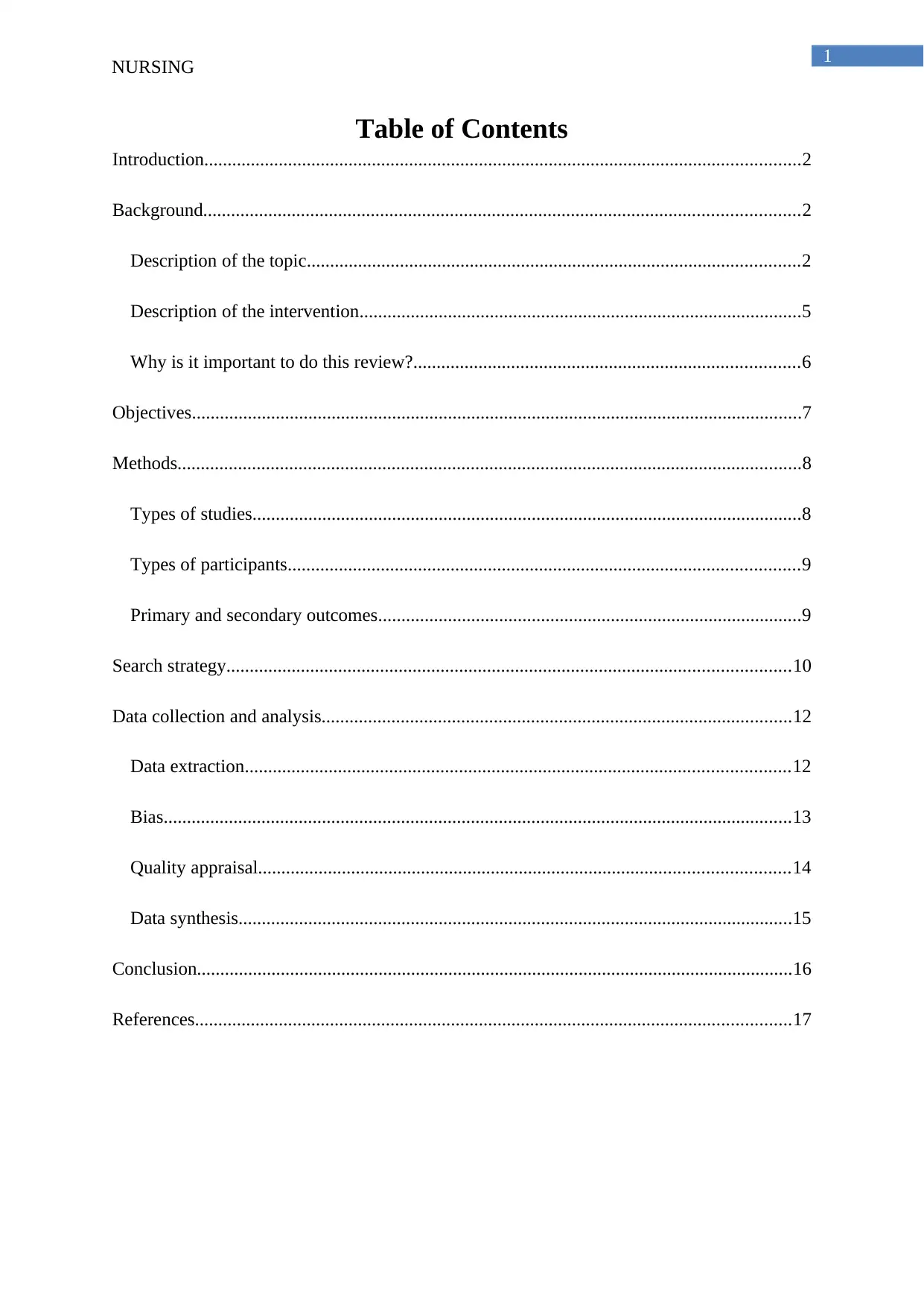
1
NURSING
Table of Contents
Introduction................................................................................................................................2
Background................................................................................................................................2
Description of the topic..........................................................................................................2
Description of the intervention...............................................................................................5
Why is it important to do this review?...................................................................................6
Objectives...................................................................................................................................7
Methods......................................................................................................................................8
Types of studies......................................................................................................................8
Types of participants..............................................................................................................9
Primary and secondary outcomes...........................................................................................9
Search strategy.........................................................................................................................10
Data collection and analysis.....................................................................................................12
Data extraction.....................................................................................................................12
Bias.......................................................................................................................................13
Quality appraisal..................................................................................................................14
Data synthesis.......................................................................................................................15
Conclusion................................................................................................................................16
References................................................................................................................................17
NURSING
Table of Contents
Introduction................................................................................................................................2
Background................................................................................................................................2
Description of the topic..........................................................................................................2
Description of the intervention...............................................................................................5
Why is it important to do this review?...................................................................................6
Objectives...................................................................................................................................7
Methods......................................................................................................................................8
Types of studies......................................................................................................................8
Types of participants..............................................................................................................9
Primary and secondary outcomes...........................................................................................9
Search strategy.........................................................................................................................10
Data collection and analysis.....................................................................................................12
Data extraction.....................................................................................................................12
Bias.......................................................................................................................................13
Quality appraisal..................................................................................................................14
Data synthesis.......................................................................................................................15
Conclusion................................................................................................................................16
References................................................................................................................................17
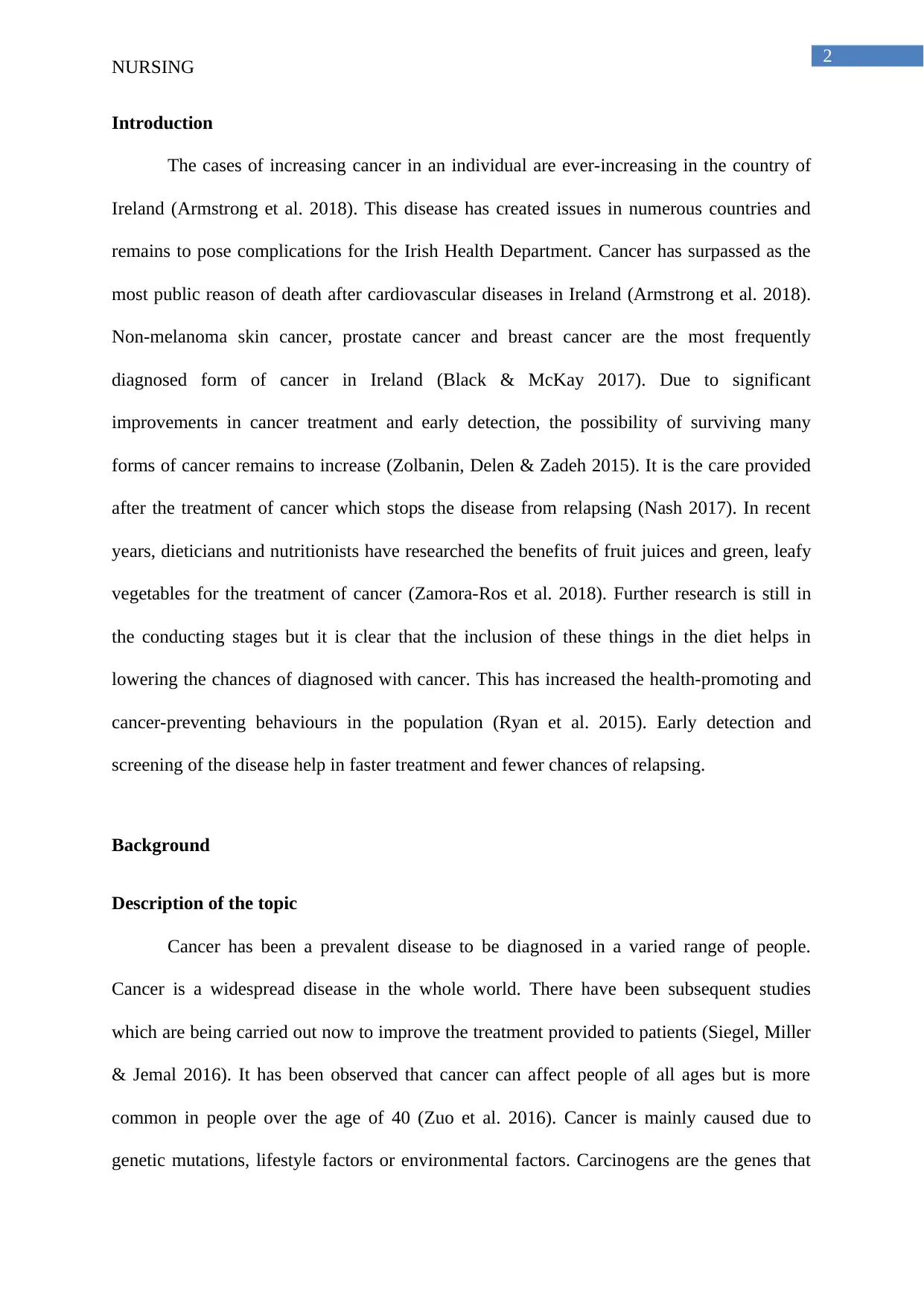
2
NURSING
Introduction
The cases of increasing cancer in an individual are ever-increasing in the country of
Ireland (Armstrong et al. 2018). This disease has created issues in numerous countries and
remains to pose complications for the Irish Health Department. Cancer has surpassed as the
most public reason of death after cardiovascular diseases in Ireland (Armstrong et al. 2018).
Non-melanoma skin cancer, prostate cancer and breast cancer are the most frequently
diagnosed form of cancer in Ireland (Black & McKay 2017). Due to significant
improvements in cancer treatment and early detection, the possibility of surviving many
forms of cancer remains to increase (Zolbanin, Delen & Zadeh 2015). It is the care provided
after the treatment of cancer which stops the disease from relapsing (Nash 2017). In recent
years, dieticians and nutritionists have researched the benefits of fruit juices and green, leafy
vegetables for the treatment of cancer (Zamora-Ros et al. 2018). Further research is still in
the conducting stages but it is clear that the inclusion of these things in the diet helps in
lowering the chances of diagnosed with cancer. This has increased the health-promoting and
cancer-preventing behaviours in the population (Ryan et al. 2015). Early detection and
screening of the disease help in faster treatment and fewer chances of relapsing.
Background
Description of the topic
Cancer has been a prevalent disease to be diagnosed in a varied range of people.
Cancer is a widespread disease in the whole world. There have been subsequent studies
which are being carried out now to improve the treatment provided to patients (Siegel, Miller
& Jemal 2016). It has been observed that cancer can affect people of all ages but is more
common in people over the age of 40 (Zuo et al. 2016). Cancer is mainly caused due to
genetic mutations, lifestyle factors or environmental factors. Carcinogens are the genes that
NURSING
Introduction
The cases of increasing cancer in an individual are ever-increasing in the country of
Ireland (Armstrong et al. 2018). This disease has created issues in numerous countries and
remains to pose complications for the Irish Health Department. Cancer has surpassed as the
most public reason of death after cardiovascular diseases in Ireland (Armstrong et al. 2018).
Non-melanoma skin cancer, prostate cancer and breast cancer are the most frequently
diagnosed form of cancer in Ireland (Black & McKay 2017). Due to significant
improvements in cancer treatment and early detection, the possibility of surviving many
forms of cancer remains to increase (Zolbanin, Delen & Zadeh 2015). It is the care provided
after the treatment of cancer which stops the disease from relapsing (Nash 2017). In recent
years, dieticians and nutritionists have researched the benefits of fruit juices and green, leafy
vegetables for the treatment of cancer (Zamora-Ros et al. 2018). Further research is still in
the conducting stages but it is clear that the inclusion of these things in the diet helps in
lowering the chances of diagnosed with cancer. This has increased the health-promoting and
cancer-preventing behaviours in the population (Ryan et al. 2015). Early detection and
screening of the disease help in faster treatment and fewer chances of relapsing.
Background
Description of the topic
Cancer has been a prevalent disease to be diagnosed in a varied range of people.
Cancer is a widespread disease in the whole world. There have been subsequent studies
which are being carried out now to improve the treatment provided to patients (Siegel, Miller
& Jemal 2016). It has been observed that cancer can affect people of all ages but is more
common in people over the age of 40 (Zuo et al. 2016). Cancer is mainly caused due to
genetic mutations, lifestyle factors or environmental factors. Carcinogens are the genes that
⊘ This is a preview!⊘
Do you want full access?
Subscribe today to unlock all pages.

Trusted by 1+ million students worldwide
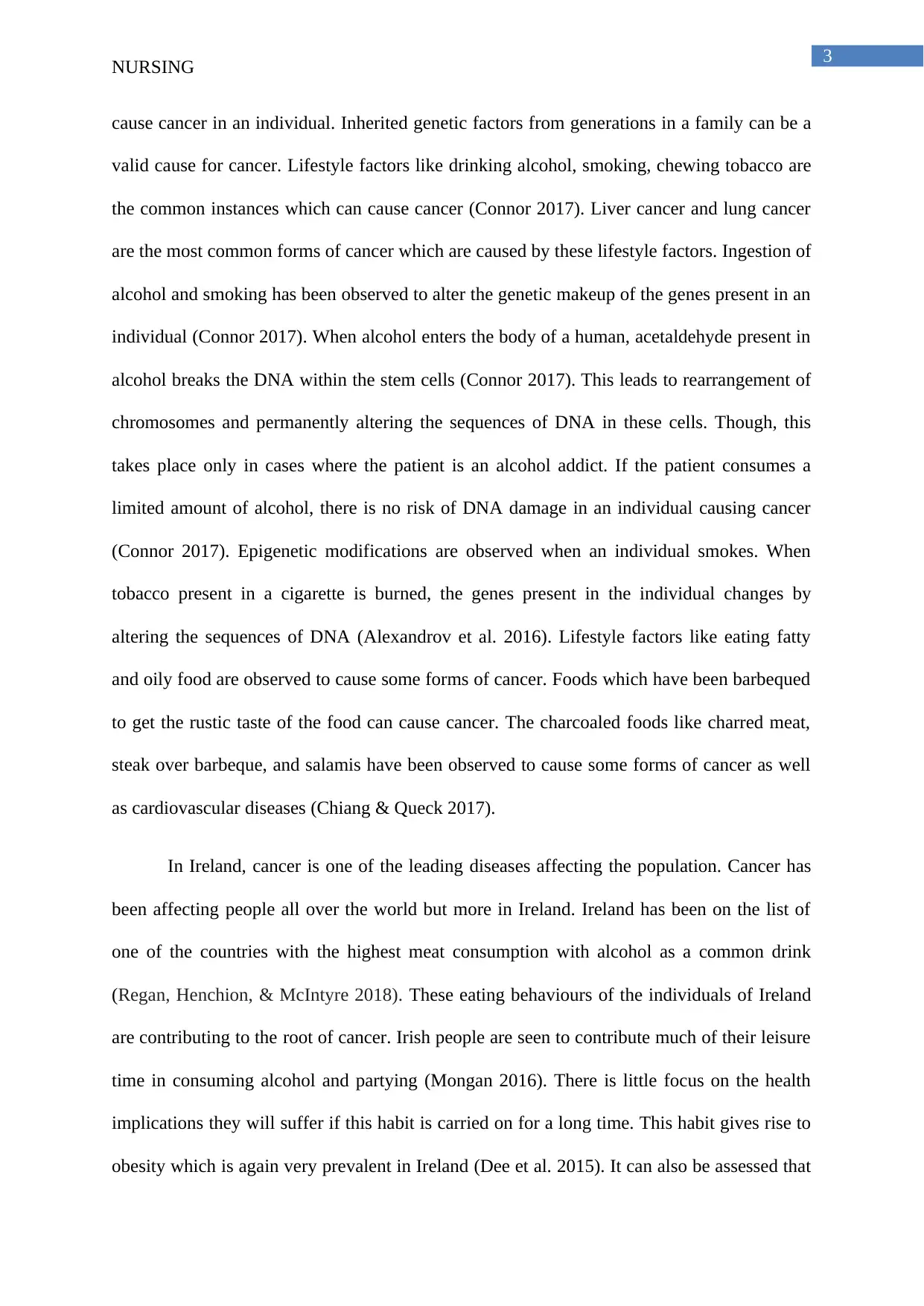
3
NURSING
cause cancer in an individual. Inherited genetic factors from generations in a family can be a
valid cause for cancer. Lifestyle factors like drinking alcohol, smoking, chewing tobacco are
the common instances which can cause cancer (Connor 2017). Liver cancer and lung cancer
are the most common forms of cancer which are caused by these lifestyle factors. Ingestion of
alcohol and smoking has been observed to alter the genetic makeup of the genes present in an
individual (Connor 2017). When alcohol enters the body of a human, acetaldehyde present in
alcohol breaks the DNA within the stem cells (Connor 2017). This leads to rearrangement of
chromosomes and permanently altering the sequences of DNA in these cells. Though, this
takes place only in cases where the patient is an alcohol addict. If the patient consumes a
limited amount of alcohol, there is no risk of DNA damage in an individual causing cancer
(Connor 2017). Epigenetic modifications are observed when an individual smokes. When
tobacco present in a cigarette is burned, the genes present in the individual changes by
altering the sequences of DNA (Alexandrov et al. 2016). Lifestyle factors like eating fatty
and oily food are observed to cause some forms of cancer. Foods which have been barbequed
to get the rustic taste of the food can cause cancer. The charcoaled foods like charred meat,
steak over barbeque, and salamis have been observed to cause some forms of cancer as well
as cardiovascular diseases (Chiang & Queck 2017).
In Ireland, cancer is one of the leading diseases affecting the population. Cancer has
been affecting people all over the world but more in Ireland. Ireland has been on the list of
one of the countries with the highest meat consumption with alcohol as a common drink
(Regan, Henchion, & McIntyre 2018). These eating behaviours of the individuals of Ireland
are contributing to the root of cancer. Irish people are seen to contribute much of their leisure
time in consuming alcohol and partying (Mongan 2016). There is little focus on the health
implications they will suffer if this habit is carried on for a long time. This habit gives rise to
obesity which is again very prevalent in Ireland (Dee et al. 2015). It can also be assessed that
NURSING
cause cancer in an individual. Inherited genetic factors from generations in a family can be a
valid cause for cancer. Lifestyle factors like drinking alcohol, smoking, chewing tobacco are
the common instances which can cause cancer (Connor 2017). Liver cancer and lung cancer
are the most common forms of cancer which are caused by these lifestyle factors. Ingestion of
alcohol and smoking has been observed to alter the genetic makeup of the genes present in an
individual (Connor 2017). When alcohol enters the body of a human, acetaldehyde present in
alcohol breaks the DNA within the stem cells (Connor 2017). This leads to rearrangement of
chromosomes and permanently altering the sequences of DNA in these cells. Though, this
takes place only in cases where the patient is an alcohol addict. If the patient consumes a
limited amount of alcohol, there is no risk of DNA damage in an individual causing cancer
(Connor 2017). Epigenetic modifications are observed when an individual smokes. When
tobacco present in a cigarette is burned, the genes present in the individual changes by
altering the sequences of DNA (Alexandrov et al. 2016). Lifestyle factors like eating fatty
and oily food are observed to cause some forms of cancer. Foods which have been barbequed
to get the rustic taste of the food can cause cancer. The charcoaled foods like charred meat,
steak over barbeque, and salamis have been observed to cause some forms of cancer as well
as cardiovascular diseases (Chiang & Queck 2017).
In Ireland, cancer is one of the leading diseases affecting the population. Cancer has
been affecting people all over the world but more in Ireland. Ireland has been on the list of
one of the countries with the highest meat consumption with alcohol as a common drink
(Regan, Henchion, & McIntyre 2018). These eating behaviours of the individuals of Ireland
are contributing to the root of cancer. Irish people are seen to contribute much of their leisure
time in consuming alcohol and partying (Mongan 2016). There is little focus on the health
implications they will suffer if this habit is carried on for a long time. This habit gives rise to
obesity which is again very prevalent in Ireland (Dee et al. 2015). It can also be assessed that
Paraphrase This Document
Need a fresh take? Get an instant paraphrase of this document with our AI Paraphraser
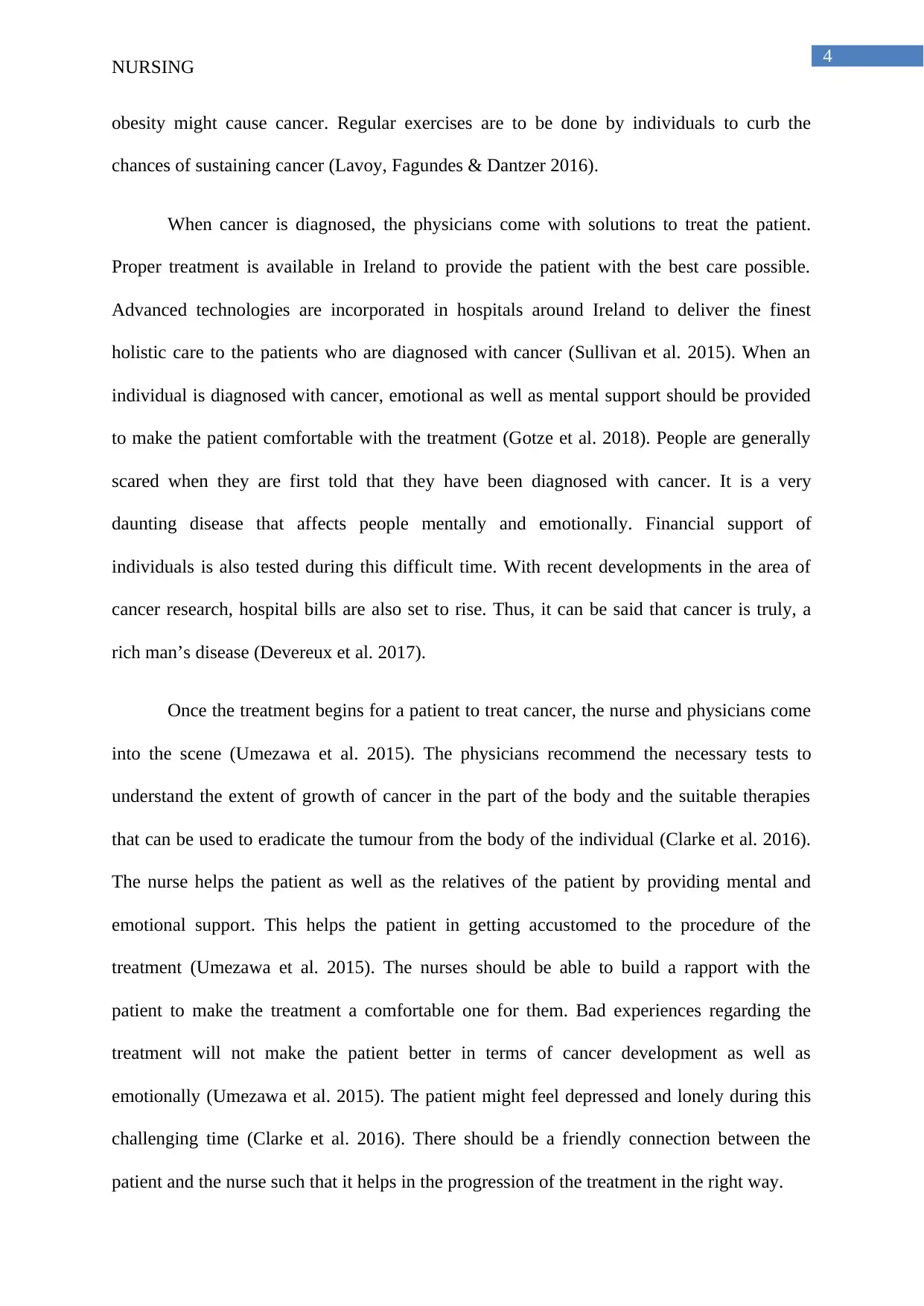
4
NURSING
obesity might cause cancer. Regular exercises are to be done by individuals to curb the
chances of sustaining cancer (Lavoy, Fagundes & Dantzer 2016).
When cancer is diagnosed, the physicians come with solutions to treat the patient.
Proper treatment is available in Ireland to provide the patient with the best care possible.
Advanced technologies are incorporated in hospitals around Ireland to deliver the finest
holistic care to the patients who are diagnosed with cancer (Sullivan et al. 2015). When an
individual is diagnosed with cancer, emotional as well as mental support should be provided
to make the patient comfortable with the treatment (Gotze et al. 2018). People are generally
scared when they are first told that they have been diagnosed with cancer. It is a very
daunting disease that affects people mentally and emotionally. Financial support of
individuals is also tested during this difficult time. With recent developments in the area of
cancer research, hospital bills are also set to rise. Thus, it can be said that cancer is truly, a
rich man’s disease (Devereux et al. 2017).
Once the treatment begins for a patient to treat cancer, the nurse and physicians come
into the scene (Umezawa et al. 2015). The physicians recommend the necessary tests to
understand the extent of growth of cancer in the part of the body and the suitable therapies
that can be used to eradicate the tumour from the body of the individual (Clarke et al. 2016).
The nurse helps the patient as well as the relatives of the patient by providing mental and
emotional support. This helps the patient in getting accustomed to the procedure of the
treatment (Umezawa et al. 2015). The nurses should be able to build a rapport with the
patient to make the treatment a comfortable one for them. Bad experiences regarding the
treatment will not make the patient better in terms of cancer development as well as
emotionally (Umezawa et al. 2015). The patient might feel depressed and lonely during this
challenging time (Clarke et al. 2016). There should be a friendly connection between the
patient and the nurse such that it helps in the progression of the treatment in the right way.
NURSING
obesity might cause cancer. Regular exercises are to be done by individuals to curb the
chances of sustaining cancer (Lavoy, Fagundes & Dantzer 2016).
When cancer is diagnosed, the physicians come with solutions to treat the patient.
Proper treatment is available in Ireland to provide the patient with the best care possible.
Advanced technologies are incorporated in hospitals around Ireland to deliver the finest
holistic care to the patients who are diagnosed with cancer (Sullivan et al. 2015). When an
individual is diagnosed with cancer, emotional as well as mental support should be provided
to make the patient comfortable with the treatment (Gotze et al. 2018). People are generally
scared when they are first told that they have been diagnosed with cancer. It is a very
daunting disease that affects people mentally and emotionally. Financial support of
individuals is also tested during this difficult time. With recent developments in the area of
cancer research, hospital bills are also set to rise. Thus, it can be said that cancer is truly, a
rich man’s disease (Devereux et al. 2017).
Once the treatment begins for a patient to treat cancer, the nurse and physicians come
into the scene (Umezawa et al. 2015). The physicians recommend the necessary tests to
understand the extent of growth of cancer in the part of the body and the suitable therapies
that can be used to eradicate the tumour from the body of the individual (Clarke et al. 2016).
The nurse helps the patient as well as the relatives of the patient by providing mental and
emotional support. This helps the patient in getting accustomed to the procedure of the
treatment (Umezawa et al. 2015). The nurses should be able to build a rapport with the
patient to make the treatment a comfortable one for them. Bad experiences regarding the
treatment will not make the patient better in terms of cancer development as well as
emotionally (Umezawa et al. 2015). The patient might feel depressed and lonely during this
challenging time (Clarke et al. 2016). There should be a friendly connection between the
patient and the nurse such that it helps in the progression of the treatment in the right way.
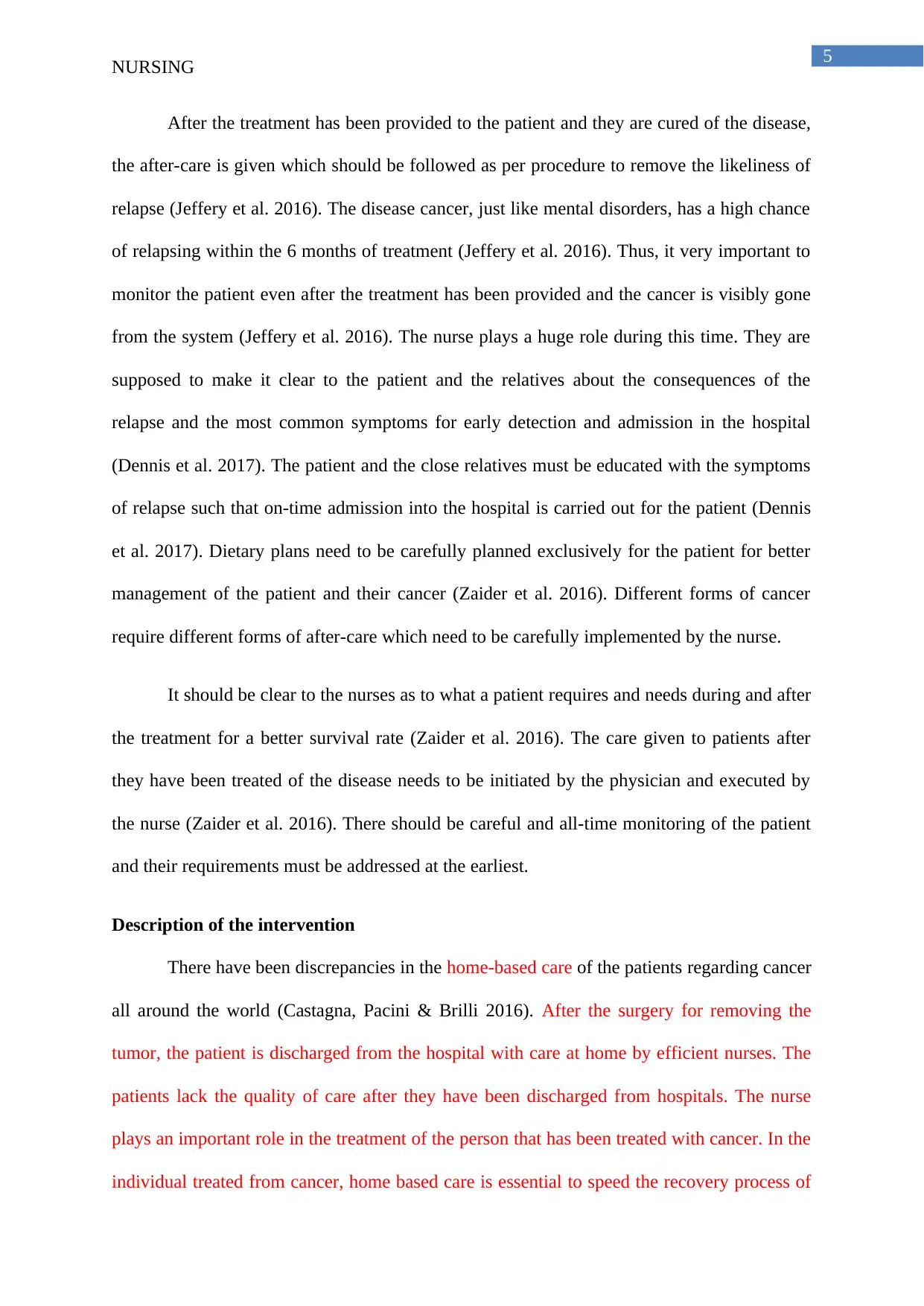
5
NURSING
After the treatment has been provided to the patient and they are cured of the disease,
the after-care is given which should be followed as per procedure to remove the likeliness of
relapse (Jeffery et al. 2016). The disease cancer, just like mental disorders, has a high chance
of relapsing within the 6 months of treatment (Jeffery et al. 2016). Thus, it very important to
monitor the patient even after the treatment has been provided and the cancer is visibly gone
from the system (Jeffery et al. 2016). The nurse plays a huge role during this time. They are
supposed to make it clear to the patient and the relatives about the consequences of the
relapse and the most common symptoms for early detection and admission in the hospital
(Dennis et al. 2017). The patient and the close relatives must be educated with the symptoms
of relapse such that on-time admission into the hospital is carried out for the patient (Dennis
et al. 2017). Dietary plans need to be carefully planned exclusively for the patient for better
management of the patient and their cancer (Zaider et al. 2016). Different forms of cancer
require different forms of after-care which need to be carefully implemented by the nurse.
It should be clear to the nurses as to what a patient requires and needs during and after
the treatment for a better survival rate (Zaider et al. 2016). The care given to patients after
they have been treated of the disease needs to be initiated by the physician and executed by
the nurse (Zaider et al. 2016). There should be careful and all-time monitoring of the patient
and their requirements must be addressed at the earliest.
Description of the intervention
There have been discrepancies in the home-based care of the patients regarding cancer
all around the world (Castagna, Pacini & Brilli 2016). After the surgery for removing the
tumor, the patient is discharged from the hospital with care at home by efficient nurses. The
patients lack the quality of care after they have been discharged from hospitals. The nurse
plays an important role in the treatment of the person that has been treated with cancer. In the
individual treated from cancer, home based care is essential to speed the recovery process of
NURSING
After the treatment has been provided to the patient and they are cured of the disease,
the after-care is given which should be followed as per procedure to remove the likeliness of
relapse (Jeffery et al. 2016). The disease cancer, just like mental disorders, has a high chance
of relapsing within the 6 months of treatment (Jeffery et al. 2016). Thus, it very important to
monitor the patient even after the treatment has been provided and the cancer is visibly gone
from the system (Jeffery et al. 2016). The nurse plays a huge role during this time. They are
supposed to make it clear to the patient and the relatives about the consequences of the
relapse and the most common symptoms for early detection and admission in the hospital
(Dennis et al. 2017). The patient and the close relatives must be educated with the symptoms
of relapse such that on-time admission into the hospital is carried out for the patient (Dennis
et al. 2017). Dietary plans need to be carefully planned exclusively for the patient for better
management of the patient and their cancer (Zaider et al. 2016). Different forms of cancer
require different forms of after-care which need to be carefully implemented by the nurse.
It should be clear to the nurses as to what a patient requires and needs during and after
the treatment for a better survival rate (Zaider et al. 2016). The care given to patients after
they have been treated of the disease needs to be initiated by the physician and executed by
the nurse (Zaider et al. 2016). There should be careful and all-time monitoring of the patient
and their requirements must be addressed at the earliest.
Description of the intervention
There have been discrepancies in the home-based care of the patients regarding cancer
all around the world (Castagna, Pacini & Brilli 2016). After the surgery for removing the
tumor, the patient is discharged from the hospital with care at home by efficient nurses. The
patients lack the quality of care after they have been discharged from hospitals. The nurse
plays an important role in the treatment of the person that has been treated with cancer. In the
individual treated from cancer, home based care is essential to speed the recovery process of
⊘ This is a preview!⊘
Do you want full access?
Subscribe today to unlock all pages.

Trusted by 1+ million students worldwide
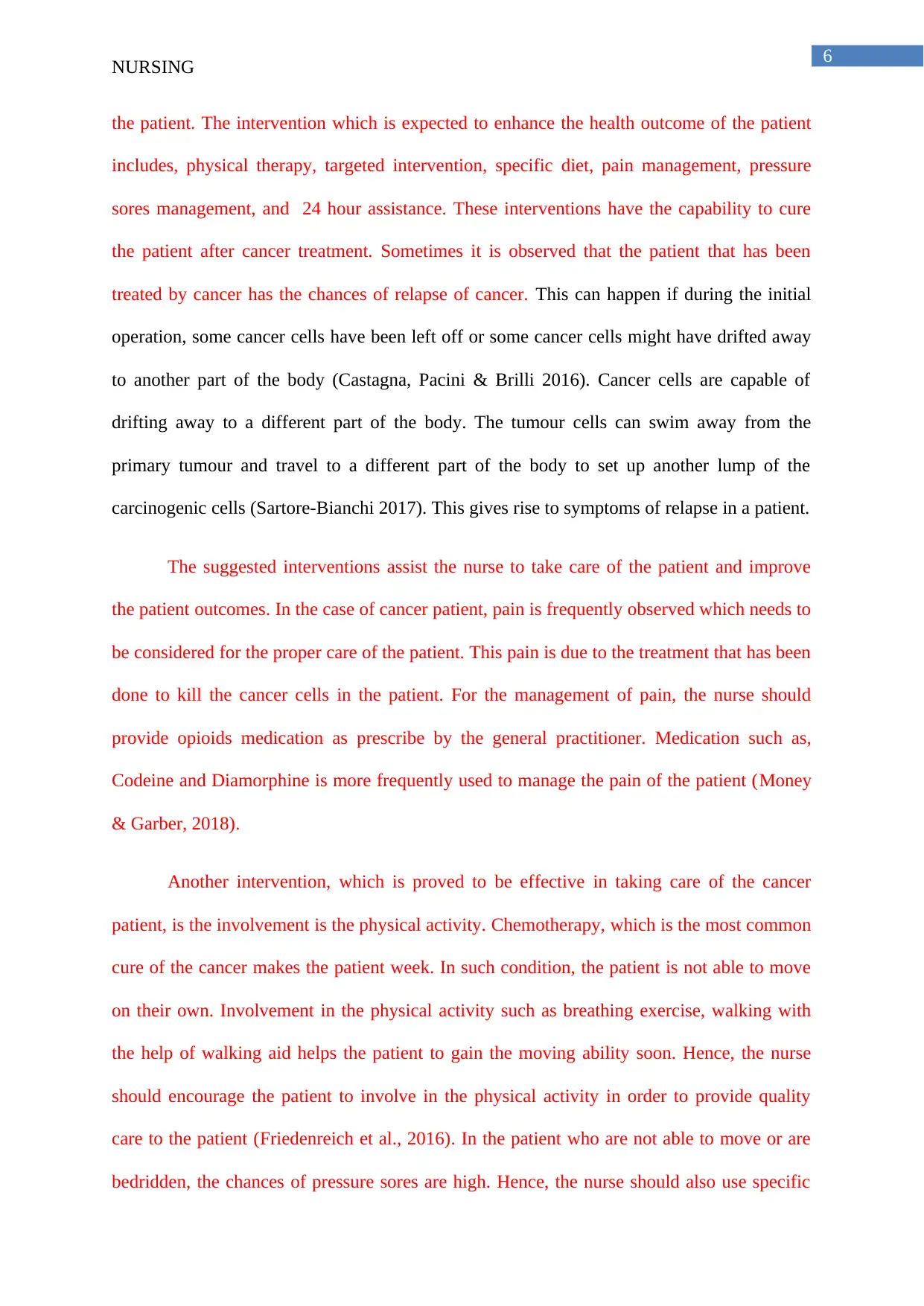
6
NURSING
the patient. The intervention which is expected to enhance the health outcome of the patient
includes, physical therapy, targeted intervention, specific diet, pain management, pressure
sores management, and 24 hour assistance. These interventions have the capability to cure
the patient after cancer treatment. Sometimes it is observed that the patient that has been
treated by cancer has the chances of relapse of cancer. This can happen if during the initial
operation, some cancer cells have been left off or some cancer cells might have drifted away
to another part of the body (Castagna, Pacini & Brilli 2016). Cancer cells are capable of
drifting away to a different part of the body. The tumour cells can swim away from the
primary tumour and travel to a different part of the body to set up another lump of the
carcinogenic cells (Sartore-Bianchi 2017). This gives rise to symptoms of relapse in a patient.
The suggested interventions assist the nurse to take care of the patient and improve
the patient outcomes. In the case of cancer patient, pain is frequently observed which needs to
be considered for the proper care of the patient. This pain is due to the treatment that has been
done to kill the cancer cells in the patient. For the management of pain, the nurse should
provide opioids medication as prescribe by the general practitioner. Medication such as,
Codeine and Diamorphine is more frequently used to manage the pain of the patient (Money
& Garber, 2018).
Another intervention, which is proved to be effective in taking care of the cancer
patient, is the involvement is the physical activity. Chemotherapy, which is the most common
cure of the cancer makes the patient week. In such condition, the patient is not able to move
on their own. Involvement in the physical activity such as breathing exercise, walking with
the help of walking aid helps the patient to gain the moving ability soon. Hence, the nurse
should encourage the patient to involve in the physical activity in order to provide quality
care to the patient (Friedenreich et al., 2016). In the patient who are not able to move or are
bedridden, the chances of pressure sores are high. Hence, the nurse should also use specific
NURSING
the patient. The intervention which is expected to enhance the health outcome of the patient
includes, physical therapy, targeted intervention, specific diet, pain management, pressure
sores management, and 24 hour assistance. These interventions have the capability to cure
the patient after cancer treatment. Sometimes it is observed that the patient that has been
treated by cancer has the chances of relapse of cancer. This can happen if during the initial
operation, some cancer cells have been left off or some cancer cells might have drifted away
to another part of the body (Castagna, Pacini & Brilli 2016). Cancer cells are capable of
drifting away to a different part of the body. The tumour cells can swim away from the
primary tumour and travel to a different part of the body to set up another lump of the
carcinogenic cells (Sartore-Bianchi 2017). This gives rise to symptoms of relapse in a patient.
The suggested interventions assist the nurse to take care of the patient and improve
the patient outcomes. In the case of cancer patient, pain is frequently observed which needs to
be considered for the proper care of the patient. This pain is due to the treatment that has been
done to kill the cancer cells in the patient. For the management of pain, the nurse should
provide opioids medication as prescribe by the general practitioner. Medication such as,
Codeine and Diamorphine is more frequently used to manage the pain of the patient (Money
& Garber, 2018).
Another intervention, which is proved to be effective in taking care of the cancer
patient, is the involvement is the physical activity. Chemotherapy, which is the most common
cure of the cancer makes the patient week. In such condition, the patient is not able to move
on their own. Involvement in the physical activity such as breathing exercise, walking with
the help of walking aid helps the patient to gain the moving ability soon. Hence, the nurse
should encourage the patient to involve in the physical activity in order to provide quality
care to the patient (Friedenreich et al., 2016). In the patient who are not able to move or are
bedridden, the chances of pressure sores are high. Hence, the nurse should also use specific
Paraphrase This Document
Need a fresh take? Get an instant paraphrase of this document with our AI Paraphraser
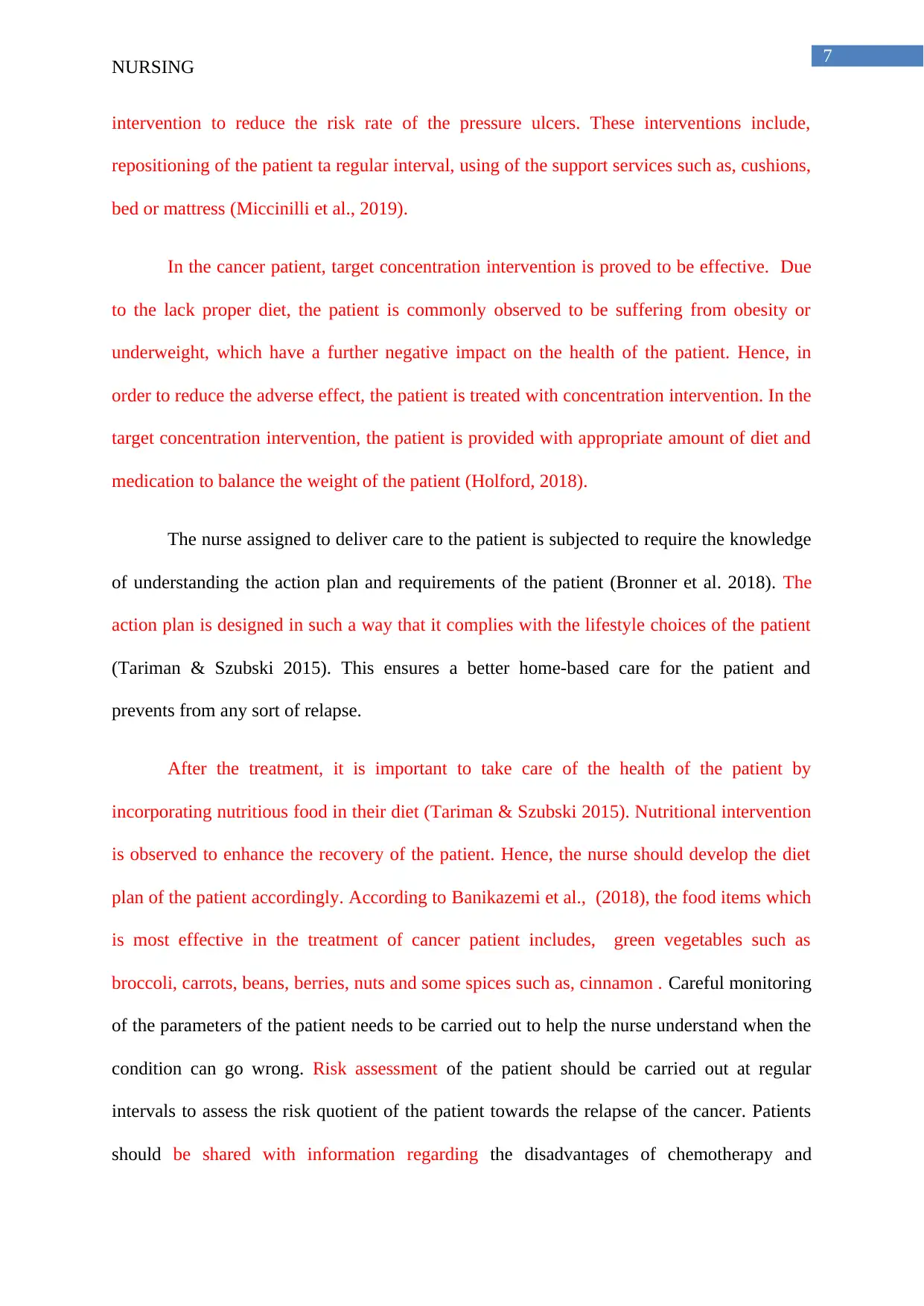
7
NURSING
intervention to reduce the risk rate of the pressure ulcers. These interventions include,
repositioning of the patient ta regular interval, using of the support services such as, cushions,
bed or mattress (Miccinilli et al., 2019).
In the cancer patient, target concentration intervention is proved to be effective. Due
to the lack proper diet, the patient is commonly observed to be suffering from obesity or
underweight, which have a further negative impact on the health of the patient. Hence, in
order to reduce the adverse effect, the patient is treated with concentration intervention. In the
target concentration intervention, the patient is provided with appropriate amount of diet and
medication to balance the weight of the patient (Holford, 2018).
The nurse assigned to deliver care to the patient is subjected to require the knowledge
of understanding the action plan and requirements of the patient (Bronner et al. 2018). The
action plan is designed in such a way that it complies with the lifestyle choices of the patient
(Tariman & Szubski 2015). This ensures a better home-based care for the patient and
prevents from any sort of relapse.
After the treatment, it is important to take care of the health of the patient by
incorporating nutritious food in their diet (Tariman & Szubski 2015). Nutritional intervention
is observed to enhance the recovery of the patient. Hence, the nurse should develop the diet
plan of the patient accordingly. According to Banikazemi et al., (2018), the food items which
is most effective in the treatment of cancer patient includes, green vegetables such as
broccoli, carrots, beans, berries, nuts and some spices such as, cinnamon . Careful monitoring
of the parameters of the patient needs to be carried out to help the nurse understand when the
condition can go wrong. Risk assessment of the patient should be carried out at regular
intervals to assess the risk quotient of the patient towards the relapse of the cancer. Patients
should be shared with information regarding the disadvantages of chemotherapy and
NURSING
intervention to reduce the risk rate of the pressure ulcers. These interventions include,
repositioning of the patient ta regular interval, using of the support services such as, cushions,
bed or mattress (Miccinilli et al., 2019).
In the cancer patient, target concentration intervention is proved to be effective. Due
to the lack proper diet, the patient is commonly observed to be suffering from obesity or
underweight, which have a further negative impact on the health of the patient. Hence, in
order to reduce the adverse effect, the patient is treated with concentration intervention. In the
target concentration intervention, the patient is provided with appropriate amount of diet and
medication to balance the weight of the patient (Holford, 2018).
The nurse assigned to deliver care to the patient is subjected to require the knowledge
of understanding the action plan and requirements of the patient (Bronner et al. 2018). The
action plan is designed in such a way that it complies with the lifestyle choices of the patient
(Tariman & Szubski 2015). This ensures a better home-based care for the patient and
prevents from any sort of relapse.
After the treatment, it is important to take care of the health of the patient by
incorporating nutritious food in their diet (Tariman & Szubski 2015). Nutritional intervention
is observed to enhance the recovery of the patient. Hence, the nurse should develop the diet
plan of the patient accordingly. According to Banikazemi et al., (2018), the food items which
is most effective in the treatment of cancer patient includes, green vegetables such as
broccoli, carrots, beans, berries, nuts and some spices such as, cinnamon . Careful monitoring
of the parameters of the patient needs to be carried out to help the nurse understand when the
condition can go wrong. Risk assessment of the patient should be carried out at regular
intervals to assess the risk quotient of the patient towards the relapse of the cancer. Patients
should be shared with information regarding the disadvantages of chemotherapy and
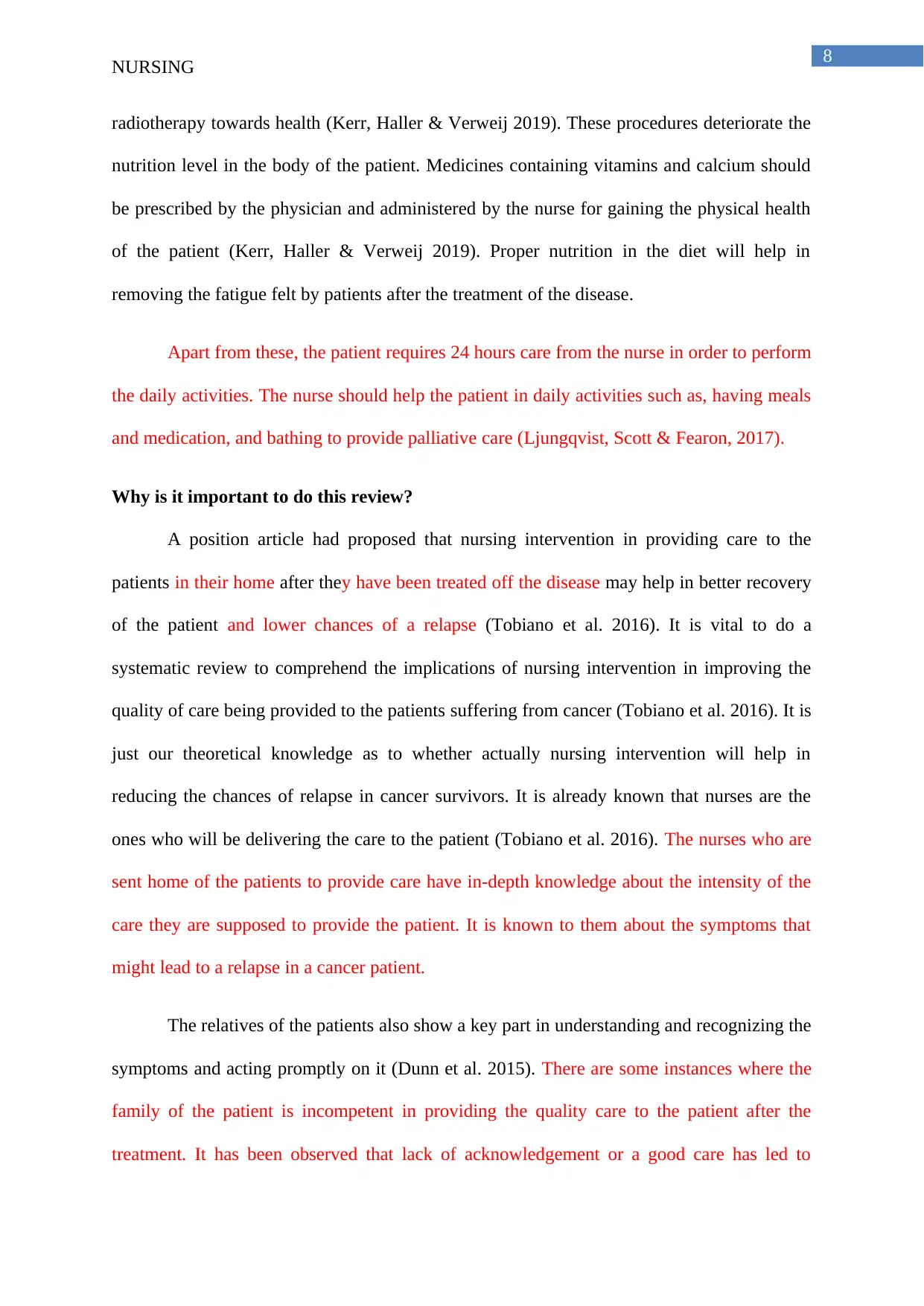
8
NURSING
radiotherapy towards health (Kerr, Haller & Verweij 2019). These procedures deteriorate the
nutrition level in the body of the patient. Medicines containing vitamins and calcium should
be prescribed by the physician and administered by the nurse for gaining the physical health
of the patient (Kerr, Haller & Verweij 2019). Proper nutrition in the diet will help in
removing the fatigue felt by patients after the treatment of the disease.
Apart from these, the patient requires 24 hours care from the nurse in order to perform
the daily activities. The nurse should help the patient in daily activities such as, having meals
and medication, and bathing to provide palliative care (Ljungqvist, Scott & Fearon, 2017).
Why is it important to do this review?
A position article had proposed that nursing intervention in providing care to the
patients in their home after they have been treated off the disease may help in better recovery
of the patient and lower chances of a relapse (Tobiano et al. 2016). It is vital to do a
systematic review to comprehend the implications of nursing intervention in improving the
quality of care being provided to the patients suffering from cancer (Tobiano et al. 2016). It is
just our theoretical knowledge as to whether actually nursing intervention will help in
reducing the chances of relapse in cancer survivors. It is already known that nurses are the
ones who will be delivering the care to the patient (Tobiano et al. 2016). The nurses who are
sent home of the patients to provide care have in-depth knowledge about the intensity of the
care they are supposed to provide the patient. It is known to them about the symptoms that
might lead to a relapse in a cancer patient.
The relatives of the patients also show a key part in understanding and recognizing the
symptoms and acting promptly on it (Dunn et al. 2015). There are some instances where the
family of the patient is incompetent in providing the quality care to the patient after the
treatment. It has been observed that lack of acknowledgement or a good care has led to
NURSING
radiotherapy towards health (Kerr, Haller & Verweij 2019). These procedures deteriorate the
nutrition level in the body of the patient. Medicines containing vitamins and calcium should
be prescribed by the physician and administered by the nurse for gaining the physical health
of the patient (Kerr, Haller & Verweij 2019). Proper nutrition in the diet will help in
removing the fatigue felt by patients after the treatment of the disease.
Apart from these, the patient requires 24 hours care from the nurse in order to perform
the daily activities. The nurse should help the patient in daily activities such as, having meals
and medication, and bathing to provide palliative care (Ljungqvist, Scott & Fearon, 2017).
Why is it important to do this review?
A position article had proposed that nursing intervention in providing care to the
patients in their home after they have been treated off the disease may help in better recovery
of the patient and lower chances of a relapse (Tobiano et al. 2016). It is vital to do a
systematic review to comprehend the implications of nursing intervention in improving the
quality of care being provided to the patients suffering from cancer (Tobiano et al. 2016). It is
just our theoretical knowledge as to whether actually nursing intervention will help in
reducing the chances of relapse in cancer survivors. It is already known that nurses are the
ones who will be delivering the care to the patient (Tobiano et al. 2016). The nurses who are
sent home of the patients to provide care have in-depth knowledge about the intensity of the
care they are supposed to provide the patient. It is known to them about the symptoms that
might lead to a relapse in a cancer patient.
The relatives of the patients also show a key part in understanding and recognizing the
symptoms and acting promptly on it (Dunn et al. 2015). There are some instances where the
family of the patient is incompetent in providing the quality care to the patient after the
treatment. It has been observed that lack of acknowledgement or a good care has led to
⊘ This is a preview!⊘
Do you want full access?
Subscribe today to unlock all pages.

Trusted by 1+ million students worldwide
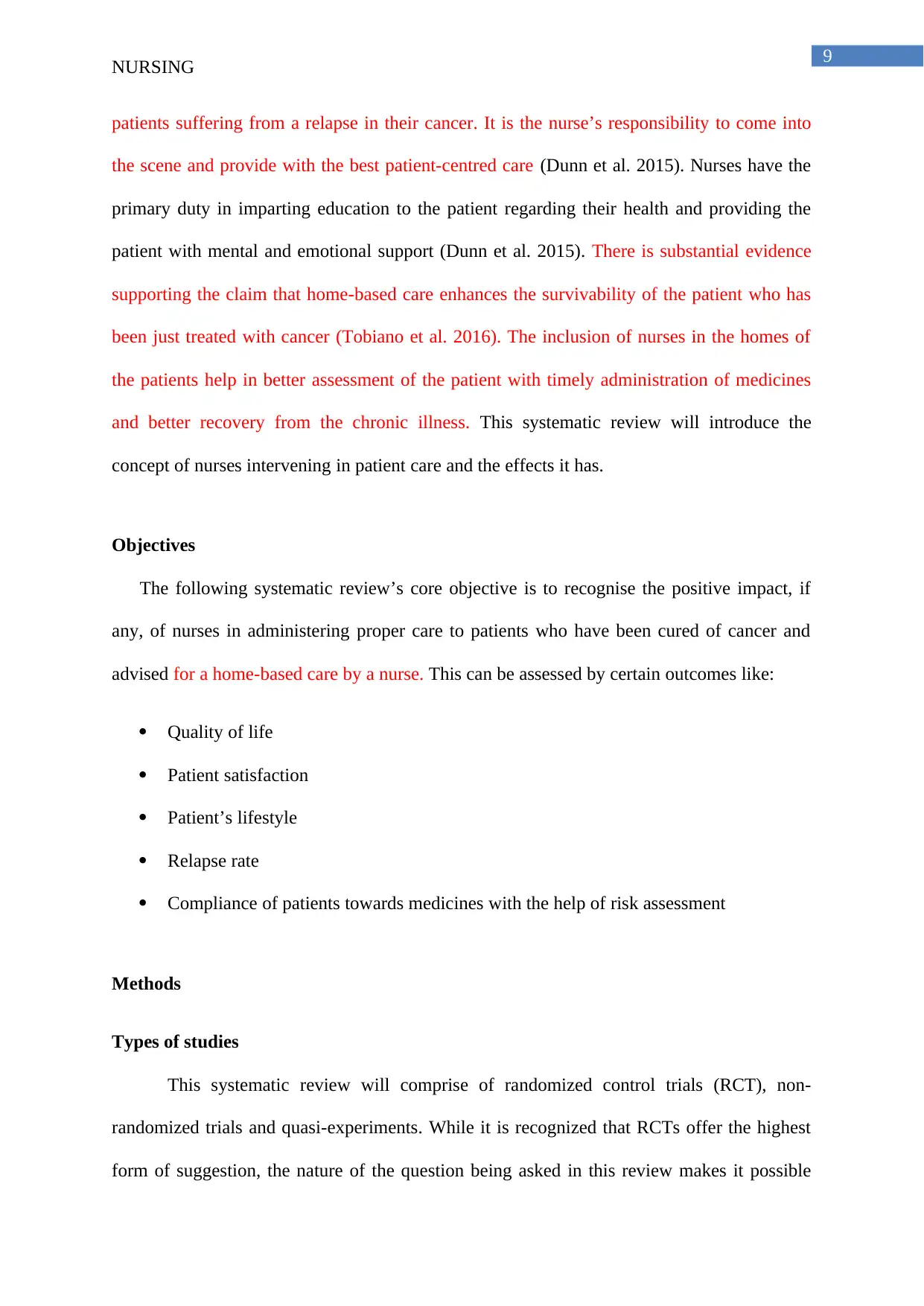
9
NURSING
patients suffering from a relapse in their cancer. It is the nurse’s responsibility to come into
the scene and provide with the best patient-centred care (Dunn et al. 2015). Nurses have the
primary duty in imparting education to the patient regarding their health and providing the
patient with mental and emotional support (Dunn et al. 2015). There is substantial evidence
supporting the claim that home-based care enhances the survivability of the patient who has
been just treated with cancer (Tobiano et al. 2016). The inclusion of nurses in the homes of
the patients help in better assessment of the patient with timely administration of medicines
and better recovery from the chronic illness. This systematic review will introduce the
concept of nurses intervening in patient care and the effects it has.
Objectives
The following systematic review’s core objective is to recognise the positive impact, if
any, of nurses in administering proper care to patients who have been cured of cancer and
advised for a home-based care by a nurse. This can be assessed by certain outcomes like:
Quality of life
Patient satisfaction
Patient’s lifestyle
Relapse rate
Compliance of patients towards medicines with the help of risk assessment
Methods
Types of studies
This systematic review will comprise of randomized control trials (RCT), non-
randomized trials and quasi-experiments. While it is recognized that RCTs offer the highest
form of suggestion, the nature of the question being asked in this review makes it possible
NURSING
patients suffering from a relapse in their cancer. It is the nurse’s responsibility to come into
the scene and provide with the best patient-centred care (Dunn et al. 2015). Nurses have the
primary duty in imparting education to the patient regarding their health and providing the
patient with mental and emotional support (Dunn et al. 2015). There is substantial evidence
supporting the claim that home-based care enhances the survivability of the patient who has
been just treated with cancer (Tobiano et al. 2016). The inclusion of nurses in the homes of
the patients help in better assessment of the patient with timely administration of medicines
and better recovery from the chronic illness. This systematic review will introduce the
concept of nurses intervening in patient care and the effects it has.
Objectives
The following systematic review’s core objective is to recognise the positive impact, if
any, of nurses in administering proper care to patients who have been cured of cancer and
advised for a home-based care by a nurse. This can be assessed by certain outcomes like:
Quality of life
Patient satisfaction
Patient’s lifestyle
Relapse rate
Compliance of patients towards medicines with the help of risk assessment
Methods
Types of studies
This systematic review will comprise of randomized control trials (RCT), non-
randomized trials and quasi-experiments. While it is recognized that RCTs offer the highest
form of suggestion, the nature of the question being asked in this review makes it possible
Paraphrase This Document
Need a fresh take? Get an instant paraphrase of this document with our AI Paraphraser
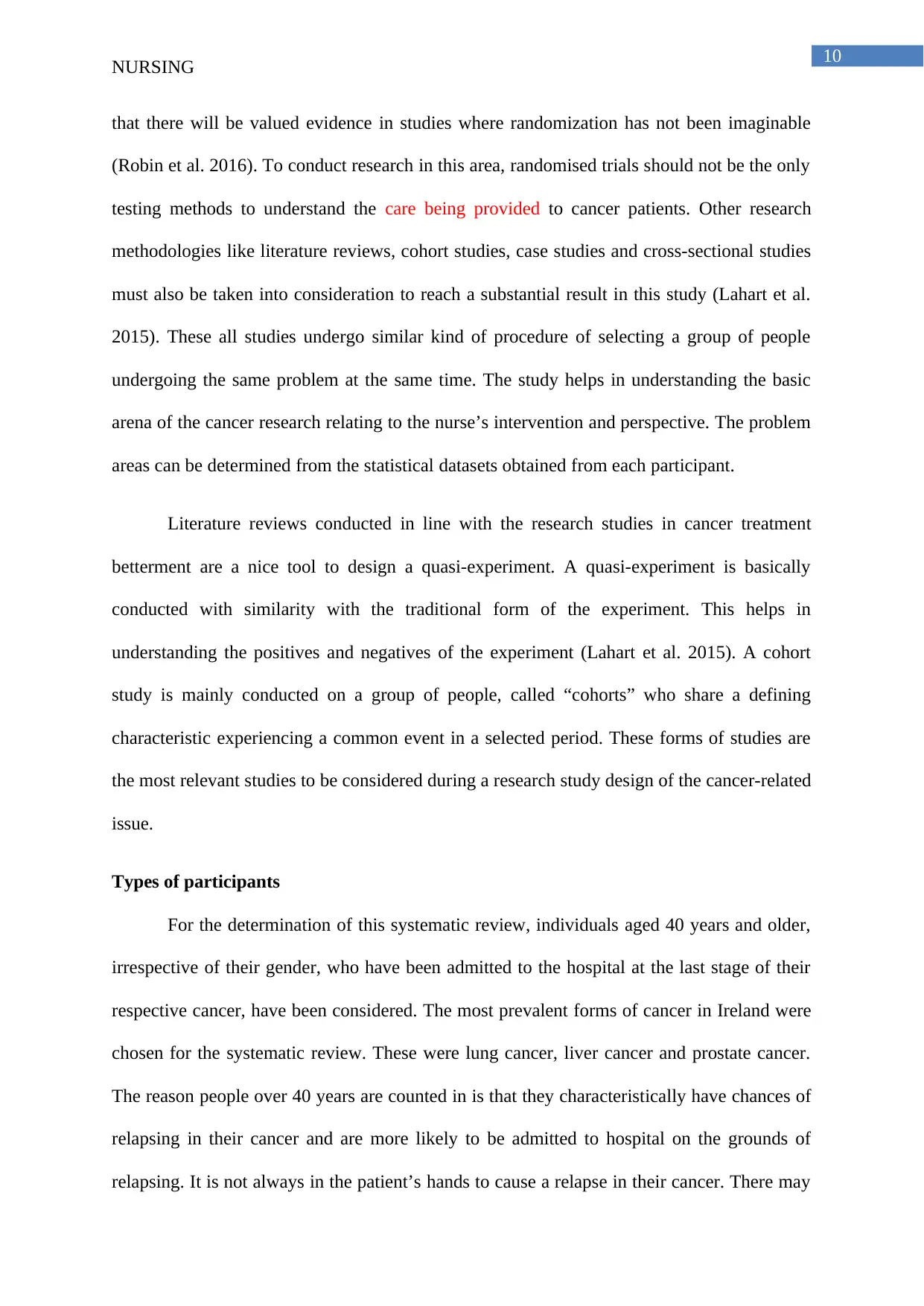
10
NURSING
that there will be valued evidence in studies where randomization has not been imaginable
(Robin et al. 2016). To conduct research in this area, randomised trials should not be the only
testing methods to understand the care being provided to cancer patients. Other research
methodologies like literature reviews, cohort studies, case studies and cross-sectional studies
must also be taken into consideration to reach a substantial result in this study (Lahart et al.
2015). These all studies undergo similar kind of procedure of selecting a group of people
undergoing the same problem at the same time. The study helps in understanding the basic
arena of the cancer research relating to the nurse’s intervention and perspective. The problem
areas can be determined from the statistical datasets obtained from each participant.
Literature reviews conducted in line with the research studies in cancer treatment
betterment are a nice tool to design a quasi-experiment. A quasi-experiment is basically
conducted with similarity with the traditional form of the experiment. This helps in
understanding the positives and negatives of the experiment (Lahart et al. 2015). A cohort
study is mainly conducted on a group of people, called “cohorts” who share a defining
characteristic experiencing a common event in a selected period. These forms of studies are
the most relevant studies to be considered during a research study design of the cancer-related
issue.
Types of participants
For the determination of this systematic review, individuals aged 40 years and older,
irrespective of their gender, who have been admitted to the hospital at the last stage of their
respective cancer, have been considered. The most prevalent forms of cancer in Ireland were
chosen for the systematic review. These were lung cancer, liver cancer and prostate cancer.
The reason people over 40 years are counted in is that they characteristically have chances of
relapsing in their cancer and are more likely to be admitted to hospital on the grounds of
relapsing. It is not always in the patient’s hands to cause a relapse in their cancer. There may
NURSING
that there will be valued evidence in studies where randomization has not been imaginable
(Robin et al. 2016). To conduct research in this area, randomised trials should not be the only
testing methods to understand the care being provided to cancer patients. Other research
methodologies like literature reviews, cohort studies, case studies and cross-sectional studies
must also be taken into consideration to reach a substantial result in this study (Lahart et al.
2015). These all studies undergo similar kind of procedure of selecting a group of people
undergoing the same problem at the same time. The study helps in understanding the basic
arena of the cancer research relating to the nurse’s intervention and perspective. The problem
areas can be determined from the statistical datasets obtained from each participant.
Literature reviews conducted in line with the research studies in cancer treatment
betterment are a nice tool to design a quasi-experiment. A quasi-experiment is basically
conducted with similarity with the traditional form of the experiment. This helps in
understanding the positives and negatives of the experiment (Lahart et al. 2015). A cohort
study is mainly conducted on a group of people, called “cohorts” who share a defining
characteristic experiencing a common event in a selected period. These forms of studies are
the most relevant studies to be considered during a research study design of the cancer-related
issue.
Types of participants
For the determination of this systematic review, individuals aged 40 years and older,
irrespective of their gender, who have been admitted to the hospital at the last stage of their
respective cancer, have been considered. The most prevalent forms of cancer in Ireland were
chosen for the systematic review. These were lung cancer, liver cancer and prostate cancer.
The reason people over 40 years are counted in is that they characteristically have chances of
relapsing in their cancer and are more likely to be admitted to hospital on the grounds of
relapsing. It is not always in the patient’s hands to cause a relapse in their cancer. There may
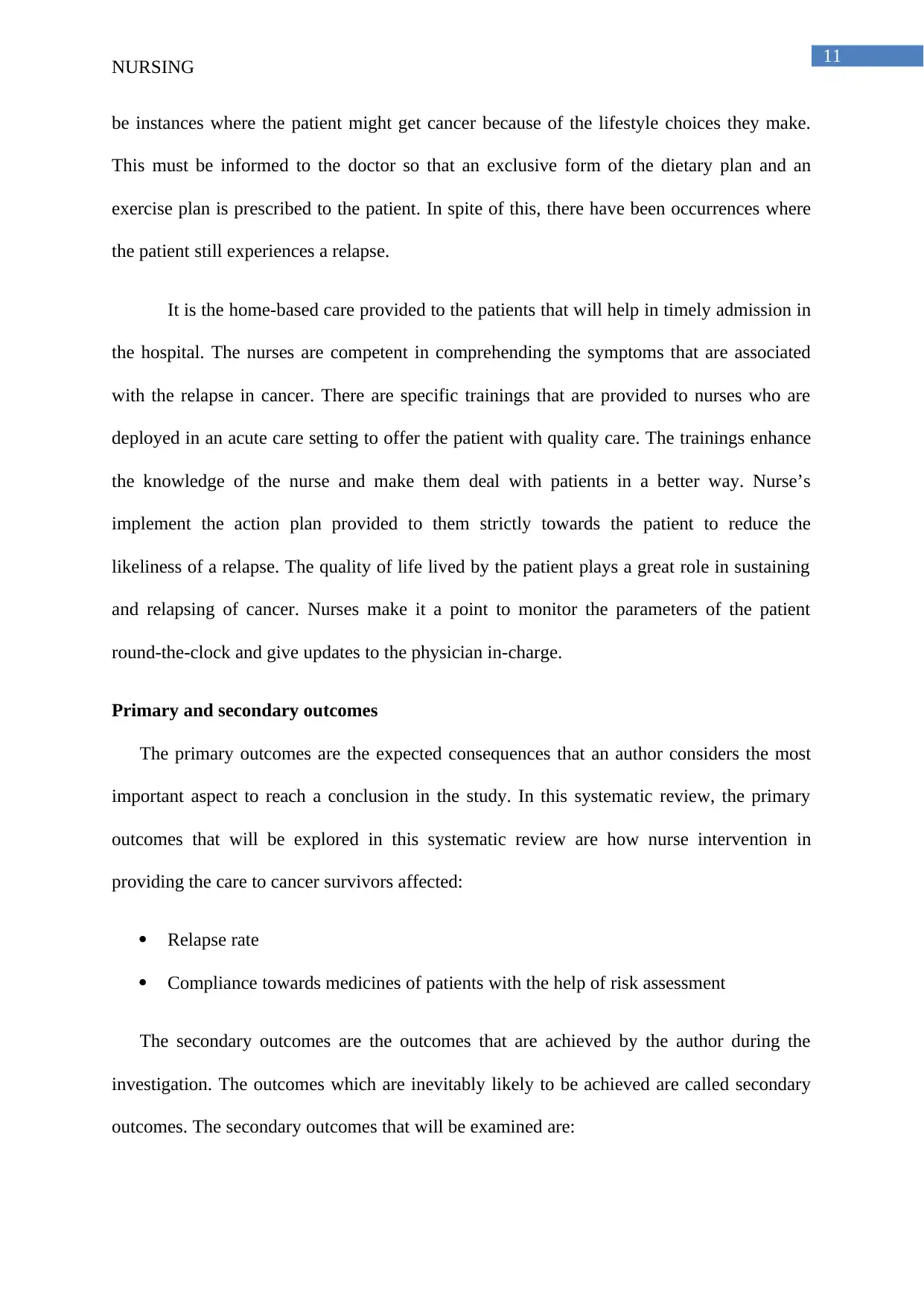
11
NURSING
be instances where the patient might get cancer because of the lifestyle choices they make.
This must be informed to the doctor so that an exclusive form of the dietary plan and an
exercise plan is prescribed to the patient. In spite of this, there have been occurrences where
the patient still experiences a relapse.
It is the home-based care provided to the patients that will help in timely admission in
the hospital. The nurses are competent in comprehending the symptoms that are associated
with the relapse in cancer. There are specific trainings that are provided to nurses who are
deployed in an acute care setting to offer the patient with quality care. The trainings enhance
the knowledge of the nurse and make them deal with patients in a better way. Nurse’s
implement the action plan provided to them strictly towards the patient to reduce the
likeliness of a relapse. The quality of life lived by the patient plays a great role in sustaining
and relapsing of cancer. Nurses make it a point to monitor the parameters of the patient
round-the-clock and give updates to the physician in-charge.
Primary and secondary outcomes
The primary outcomes are the expected consequences that an author considers the most
important aspect to reach a conclusion in the study. In this systematic review, the primary
outcomes that will be explored in this systematic review are how nurse intervention in
providing the care to cancer survivors affected:
Relapse rate
Compliance towards medicines of patients with the help of risk assessment
The secondary outcomes are the outcomes that are achieved by the author during the
investigation. The outcomes which are inevitably likely to be achieved are called secondary
outcomes. The secondary outcomes that will be examined are:
NURSING
be instances where the patient might get cancer because of the lifestyle choices they make.
This must be informed to the doctor so that an exclusive form of the dietary plan and an
exercise plan is prescribed to the patient. In spite of this, there have been occurrences where
the patient still experiences a relapse.
It is the home-based care provided to the patients that will help in timely admission in
the hospital. The nurses are competent in comprehending the symptoms that are associated
with the relapse in cancer. There are specific trainings that are provided to nurses who are
deployed in an acute care setting to offer the patient with quality care. The trainings enhance
the knowledge of the nurse and make them deal with patients in a better way. Nurse’s
implement the action plan provided to them strictly towards the patient to reduce the
likeliness of a relapse. The quality of life lived by the patient plays a great role in sustaining
and relapsing of cancer. Nurses make it a point to monitor the parameters of the patient
round-the-clock and give updates to the physician in-charge.
Primary and secondary outcomes
The primary outcomes are the expected consequences that an author considers the most
important aspect to reach a conclusion in the study. In this systematic review, the primary
outcomes that will be explored in this systematic review are how nurse intervention in
providing the care to cancer survivors affected:
Relapse rate
Compliance towards medicines of patients with the help of risk assessment
The secondary outcomes are the outcomes that are achieved by the author during the
investigation. The outcomes which are inevitably likely to be achieved are called secondary
outcomes. The secondary outcomes that will be examined are:
⊘ This is a preview!⊘
Do you want full access?
Subscribe today to unlock all pages.

Trusted by 1+ million students worldwide
1 out of 27
Related Documents
Your All-in-One AI-Powered Toolkit for Academic Success.
+13062052269
info@desklib.com
Available 24*7 on WhatsApp / Email
![[object Object]](/_next/static/media/star-bottom.7253800d.svg)
Unlock your academic potential
Copyright © 2020–2025 A2Z Services. All Rights Reserved. Developed and managed by ZUCOL.





